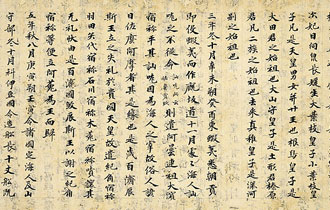Pages |
In the formal colonies of Taiwan and Korea, the populations were considered subjects of the Japanese Empire and, therefore, all attempts at creating a national or cultural identity separate from Japan were prohibited. In Manchukuo, however, nominal independence created ideological breathing room, a freedom which some Japanese saw as an opportunity to create a new kind of culture and national identity for the inhabitants there.
Japanese officials tried to create a new "Manchurian" national consciousness which they hoped would replace Chinese nationalistic identity among the majority Han Chinese. At first, they tried to forge this identity by employing familiar Chinese models, which they expected would mask Japanese control. They used Confucian terminology and appealed to historical precedents to try to legitimize the creation of an independent northeastern state. In time, however, the weight of Japanese demands for empire-wide ideological orthodoxy led the Manchukuo leaders to abandon the Chinese models and instead portray the state as client, dependent on the Japanese Emperor and in need of an injection of Japan's superior culture. Leading Japanese officials began to support forcing the Chinese to follow Japanese linguistic and ceremonial forms in hopes that it would cause them to appreciate and even willingly support the Japanese effort to create a unified Greater East Asia. In other words, their goals changed from one of creating a new ethnicity to one of recreating Japaneseness. Ultimately, however, both proved unsuccessful.
War with China
In July 1937, Japan and China went to war against each other, and in December 1941 Japan attacked American and British forces, thereby beginning the Pacific War. From 1937, Japan came to control large swaths of the most populated areas of China, and from 1941 until its defeat in 1945, it took control of more regions in Southeast Asia and the Pacific.
In constructing justifications for its domination of foreign lands, Japan faced the problem of how to legitimize imperialist expansion in a world where colonialism was no longer legitimate. Like other imperialist powers of the time, it had to disguise its domination in new language that made it seem as though they were actually respecting Wilsonian concepts of self-rule.
In 1940, Japan established a reorganized Nationalist Government of China at Nanjing and allowed this puppet government to use the symbols of Chinese nationalism it had avoided using in Manchukuo. While the puppet government in Manchukuo had rejected Sun Yatsen's "Three Principles of the People," the new Nanjing government, manned by former Guomindang members, openly embraced them, declaring itself the true successor to Sun's legacy. The Japanese even let the new Nanjing government use the tricolor Guomindang flag, albeit with a small pennant proclaiming "peace, national reconstruction, and anticommunism." In reality, however, the regime was not so different from Manchukuo, for its Japanese advisers were controlling policies at almost every level.
The second ideological problem was how to interpret the expansion of the wartime empire beyond the boundaries of the Sinitic world. In the Meiji empire, notions of common culture and common race were plausible justifications for colonial domination, and to speak of helping "younger brothers" in Taiwan or Korea made some sense. But the wartime empire included places that had little in common with Japan. The ideological framework built to legitimate the Meiji government's colonial expansion, therefore, had to be revamped so as to justify the inclusion of Southeast Asia. In June 1940, Foreign Minister Arita Hachirō put forth a new vision. He said it was natural for those closely related geographically, racially, and economically to form a sphere for their own coexistence and co-prosperity and to establish peace and order within that sphere. In August, the new Foreign Minister, Matsuoka Yōsuke, gave this vision a name: the Greater East Asia Co-Prosperity Sphere. What is striking about the concept is how rapidly it acquired the status and legitimacy of a national goal.
Pages |











